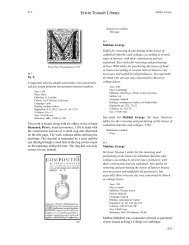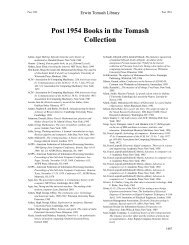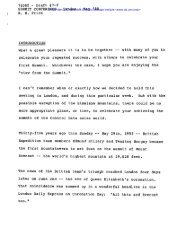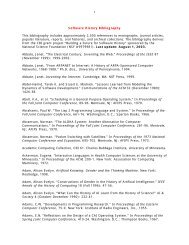B chapter.indd - Charles Babbage Institute - University of Minnesota
B chapter.indd - Charles Babbage Institute - University of Minnesota
B chapter.indd - Charles Babbage Institute - University of Minnesota
You also want an ePaper? Increase the reach of your titles
YUMPU automatically turns print PDFs into web optimized ePapers that Google loves.
Erwin Tomash Library<br />
Boissière, Claude de Boissière, Claude de<br />
Jean Boisseau was a French geographer and genealogist<br />
who had an appointment as Enlumineur du Roi.<br />
This is a multiplication table in the form <strong>of</strong> a large<br />
circular volvelle (lacking the movable pointer). The<br />
device consists <strong>of</strong> thirty-seven concentric circles<br />
containing multiples <strong>of</strong> numbers found in the innermost<br />
circle. To multiply, one found the number (or one <strong>of</strong> its<br />
components, as after 10, only multiples <strong>of</strong> 10, 100, or<br />
1000 are shown) in the innermost circle, then moved<br />
the pointer (which evidently had the same markings as<br />
the sector with the multiples <strong>of</strong> 1 inscribed in it) to that<br />
sector. The product could be found by inspecting the<br />
value in the outer circle corresponding to the multiplier<br />
(or one <strong>of</strong> its components).<br />
The conversion table on the second sheet gives various<br />
systems <strong>of</strong> weights and measures for different goods:<br />
cloth <strong>of</strong> various kinds and origins, grains, wine, gold,<br />
time and distance, with the factors for converting them<br />
to the French systems.<br />
This device was known to Harsdörffer (see entry for<br />
Schwenter, Daniel and Harsdörffer, Georg Phillip;<br />
Deliciae physico-mathematicae, 1651), who reproduced<br />
a modified version. Leupold (Theatrum, 1727) also<br />
reproduced a version but had to rely on Schwenter’s<br />
example as he could not find an original. No other<br />
original example <strong>of</strong> this work is known.<br />
Illustrations available:<br />
Several scans, each showing a portion <strong>of</strong> the large instrument.<br />
B 190<br />
Boissière, Claude de (1554–1608)<br />
L’ art d’arythmetique contenant toute dimention, tres<br />
singulier et commode, tant pour l’art militaire, que<br />
autres calculations<br />
Year: 1554<br />
Place: Paris<br />
Publisher: Annet Briere<br />
Edition: 1st<br />
Language: French<br />
Binding: modern leather; covers gilt embossed; gilt spine<br />
Pagination: ff. 72<br />
Collation: A–I 8<br />
Size: 170x105 mm<br />
Reference: Smi Rara, pp 260–262<br />
Claude de Boissière was a philosopher, astronomer,<br />
mathematician and musician born near Grenoble.<br />
This arithmetic book is considered by some to have been<br />
written for students at the <strong>University</strong> <strong>of</strong> Paris. Smith<br />
(History <strong>of</strong> mathematics) prefers to classify Boissière as<br />
a dilettante <strong>of</strong> mathematics.<br />
The text is a combination <strong>of</strong> an elementary practical<br />
arithmetic and a discussion <strong>of</strong> theoretical aspects much<br />
like those treated by Boethius. It not only begins with<br />
simple numeration but carries this to the extreme. It<br />
mentions the usual orders such as units, tens, hundreds,<br />
etc. but also extends the system to Mille de Quintillions<br />
(thousands <strong>of</strong> quintillions). It is interesting that this<br />
section gives names for orders such as bimillions (a<br />
million million), trimillions (a million million million),<br />
quadrimillion, etc. but then indicates that it is suitable<br />
to shorten these names to billion or trillion to avoid<br />
confusion.<br />
B 190<br />
Pythagorean example, B 190<br />
After treating the four standard arithmetical operations<br />
(the only interesting variant is that he does subtraction<br />
very differently from the way it is done today—see<br />
illustration), he proceeds to a second book, in which he<br />
treats the more theoretical subjects. He considers not<br />
only the usual Boethian type <strong>of</strong> figurative numbers but<br />
167







